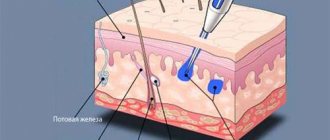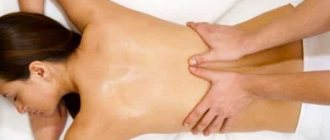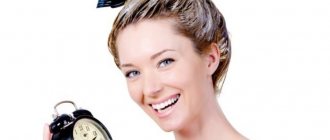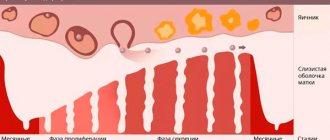Every healthy woman of childbearing age has a menstrual cycle. And the so-called “critical days” are the peak of hormonal changes in the body. It is characterized by pain, mood swings and other changes in physical condition and behavior that are not present at other times.
Interestingly, many at this time experience extreme dissatisfaction with themselves and a desperate desire to change something. And often changes begin with your own appearance. What's easier to change than a haircut or hair color? But many believe that these are just the most inappropriate days for coloring. Is it possible to do highlighting during menstruation, and what risks arise?
Is it possible to do highlighting during menstruation?
It has still not been possible to give an exact answer to this question, since much here depends on the woman’s body. For some, due to a strong hormonal imbalance, not a single dye is taken. But aggressive substances continue to affect the hair during the procedure, which leads to significant damage.
Similar results are obtained in approximately half of women who decide to undergo highlighting during menstruation.
But another part of the hairdresser’s clients obtained the required color, and a number of women noted receiving a more saturated shade.
The hair remained completely healthy and shiny.
Since it is impossible to predict how your curls will behave during the procedure during menstruation, you can agree with the master to dye only a few strands.
If they have the required color, coloring can continue.
Possible risks: what could go wrong?
When making an appointment for highlighting during your period, you should be prepared for the following consequences:
- the hair will not be dyed at all or the color will differ from the desired one;
- due to increased sensitivity, the scalp may begin to peel and dandruff may appear;
- the hair follicle may react poorly to the dye used, which will cause hair loss, brittleness and dryness;
- bleached strands will become a pronounced green shade;
- the applied pigment will quickly be washed off from the curls.
Read about the dangers and pros and cons of highlighting here.
When to highlight your hair and should you worry?
On the forums you can find different opinions on this matter. Some people advise not to worry at all and come to the procedure calmly.
But most experts still recommend postponing going to the hairdresser, so as not to have to think about how to remove the green or yellow tint from your hair (read about how to correct unsuccessful hair highlighting at home).
If you have previously had experience of dyeing your hair during menstruation or a few days before it, the color was the desired shade and there was no brittleness or dryness, then calmly use the services of a hairdresser at any time of the month.
Hair coloring during menstruation: a risk or a common procedure?
For a modern woman, hair coloring is a common procedure that many people resort to.
Menstrual cycles are just as familiar to women. Since certain chemical compounds included in most hair dyes have an effect on the body, the question involuntarily arises as to whether it is possible to dye hair during menstruation. How compatible are these two points, are there any contradictions between them?
What do gynecologists say?
The changes affecting the hormonal background of the female body during menstruation are profound and serious . The maturation of the egg is accompanied by global jumps in the quantitative indicators of hormones.
The percentage of progesterone and estrogen, the hormones responsible for reproductive functions, changes significantly.
The peak of the hormonal surge occurs in the days before and after menstruation. At this time, the woman experiences pain and heaviness in the lower abdomen. Hair, nails and skin are exposed to stress.
Sharp changes in hormonal balance also affect the hormone responsible for hair color. In the first days of regulation, melanin levels increase, which is fraught with surprises in obtaining the desired shade.
Gynecologists believe that any irritating external effect on the body during this period is undesirable .
Problems with changing hair color
Melanin is known to be responsible for the color of hair on the human body. Its saturation in the body determines what a person’s natural hair color will be.
If a type of hormone such as zumelanin prevails among the coloring pigments, the hair becomes dark chestnut or black. With a high content of pheomelanin, we get light hair with light brown, red and straw shades.
Hair dyes contain certain chemical compounds that can destroy the natural pigment of the hair . They displace it, replacing it with dyes, and give the hair the chosen tone.
On menstrual days, when levels of reproductive hormones destabilize, melanin levels also become feverish.
Gynecologists do not advise resorting to coloring these days , so as not to be surprised by the result obtained: the shade that appears will be completely different from what you expected.
What can cause hair coloring during menstruation?
In every woman’s life, situations arise when it is necessary to urgently correct the color of her curls. If such a problem coincides with your period, in order not to risk your entire head of hair, you can tint only the roots .
It would be better to refrain from a radical change of color, remembering: gynecologists warn about the unpredictability of the result during this period. What could happen?
Spotted effect
The “floating” level of melanin provokes fragmentary fixation of the coloring composition. This means that you won’t get a uniform tone; it will form unsightly spots. Is it possible to do highlighting during menstruation? Considering the above, it is worth holding off on changing your image .
As a result of a conflict between the chemical pigment and melanin, when the former is poorly absorbed by the hair structure, the “leopard color” effect is likely. Some women who encountered this phenomenon were forced to cut off their luxurious hair.
Lack of stamina
Poor fixation of the dye or its complete rejection is observed among those girls who like to radically change the color of their hair.
The reason lies in the “immunity” that melanin acquires during such frequent experiments. Most often, a negative result is obtained during menstruation.
Structural deterioration
In itself, changing hair color using chemical dyes causes significant harm to it. Brittleness appears, hair becomes dry, split, and dull .
To maintain their health, you have to resort to various restorative procedures: make masks, use balms, drink vitamins.
https://www.youtube.com/watch?v=8arnlb4HaZs
During menstruation, the risk of deterioration of the hairline increases. Ladies who were forced to change or tint their hair color during menstruation noted that their hair turned into wire, became thinner and resembled dry tufts of tow.
Here is your answer why you should not dye your hair on menstrual days.
Changing shade
The use of tinted shampoos is also associated with risk. The “behavior” of melanin on menstruation days is individual , and it is impossible to say whether the paint will take as it should.
Side effects
If only color unpredictability accompanied menstrual hair coloring. The stressful state of the body these days can provoke:
- severe allergies;
- irritation of mucous membranes, especially eyes;
- manifestation of migraine, dizziness may occur;
- intoxication;
- rupture of capillary walls.
How do hairdressers feel about dyeing hair during menstruation?
Most hairdressers are skeptical about doctors' opinions regarding hair coloring during menstruation. They confidently declare that the procedure does not cause any harm or negative results.
The only limitation that professionals voice is the refusal to combine several procedures . For example, only coloring or only curling.
What to do to avoid negative consequences?
By combining the opinions of doctors and hairdressers, you can draw up rules for the “golden mean” for critical days, when your hair is dyed, and you don’t want to run away in horror from the result:
- Do not change your hair color radically . It is enough to take the composition several tones darker or lighter.
- Warn the technician about a sensitive problem. He will select paint with gentle characteristics.
- No aggressive dyes , which are used, for example, for radical lightening.
- Be sure to test the chosen product for an allergic reaction and irritation.
- Use an already proven preparation for coloring , since it is difficult to predict the body’s reaction to a new composition.
- When dyeing at home, experts recommend adding heat treatment to it . This means that after applying the paint you should put on a cap and warm your hair with a hairdryer. This manipulation neutralizes temperature changes and prevents hair fragility.
- When washing off the dye, use not only a balm, but also a tinted shampoo so as not to encounter the appearance of “leopard color.”
- Color only the roots , without affecting the entire length of the strands.
When is it really necessary?
If the need to touch up or change color falls on critical days, you should consult with your master. As an alternative, you can use tint compositions in the form of shampoo or balm .
Traditional methods
At all times, women have strived to improve their appearance. In the absence of developed technologies, folk remedies were used, and they were also used in hair coloring.
Various plants became the main supplier of coloring compounds. You can also resort to folk methods on critical days, the main thing is to choose the right composition for your hair color.
For light strands: chamomile decoction
Prepare a decoction based on chamomile flowers , taking 2 tablespoons of dry raw materials and 1 cup of boiling water. Fill the flowers with water and leave them for 1 hour. Rinse your hair with the resulting solution.
For a visible effect, the procedure is carried out several times with a break of 2-3 days. If you use fresh flowers, collected yourself, you need to pour a glass of flowers with 1 liter of water and boil for 5 minutes.
For dark skin: onion skins
We all know what color the shells of Easter eggs acquire if they are boiled in onion skins. We get the same effect if we use a similar decoction for hair coloring.
We collect 100 g of husks, add a glass of water and cook for about 7 minutes. We wait until our natural dye cools down. Then we distribute it among the strands and leave for 15–20 minutes.
Black tea for russets
To dye your hair with tea, you need to take only leaf varieties; teabags will not help. For 3-4 tablespoons of tea you will need 0.5 liters of water. Pour in the tea leaves, bring to a boil, and keep on medium heat for 15 minutes. Turning it off, let the broth brew for an hour.
Distribute the cooled broth over all strands, starting from the roots. Cover your head with film or a cap and keep it there for 30–40 minutes. Rinse with water. If you want a chocolate tone, add a little coffee to your tea.
After reading the opinions of doctors and hairdressers, we received conflicting answers. This means that when it comes to hair coloring during menstruation, a woman must make her own decision .
Take into account the stated risks, carry out preliminary preparations, and only then make a choice.
Source: https://figaro.space/okrashivanie/mozhno-li-krasit-volosy-pri-mesyachnyh.html
Advice from hairdressers before the procedure
Taking into account world experience, the best hairdressers have put together a number of effective tips for those who decide to highlight their hair during menstruation.
- Try to carry out the procedure in the middle or end of your period. At this time, hormonal levels begin to improve and the risk of unexpected situations decreases.
- Be sure to wear a plastic cap on dyed hair. It will create a greenhouse effect, which will have a beneficial effect on the dye.
- Be sure to check with the master what kind of paint he uses. A self-respecting salon applies only professional dyes to your hair, which rarely show negative results.
- If you are dyeing your hair for the first time and it has a dark color, you should be prepared that the first time the shade will not be as snow-white as you would like.
- To prevent the color from quickly washing away, you need to use special shampoos and balms (care after coloring is described here).
If you decide to sign up for highlighting during your period, you should follow the recommendations of the specialist.
This will significantly reduce the risk of developing undesirable consequences, including uneven coloring or unexpected colors.
At the same time, most hairdressers strongly recommend that, if possible, it is better to make an appointment for another time when the hormonal levels return to normal.
Highlighting is one of the main hair coloring techniques in modern cosmetology. But everything has its own nuances. For some reason, it is during the so-called “critical days” that women are often drawn to change something in their appearance.
And many people think about whether it is possible to color their hair at this time, for example, using such a popular technique as highlighting. Even experts have different opinions on this matter, but in any case it is worth knowing about the possible risks.
Is it worth the risk?
Whether it’s worth risking your own hair and getting highlights during your period is something everyone decides for themselves. It is impossible to give a definite answer here. If you have already had a negative experience with coloring on “critical days,” then it is better not to experiment a second time, but to go to the hairdresser at least after 5-6 days of the cycle.
If you really need to look good these days, you can solve the problem with the help of tinting. Of course, this will only give a temporary effect, but the risk of additional hair damage will be minimized. After all, if highlighting or coloring is unsuccessful, the procedure will have to be repeated in a few days.
You definitely can’t do highlighting, or indeed go to the hairdresser, if under the influence of hormones you are in a very irritated or depressed state. Not only will you pour negativity on the master, but you will also be dissatisfied with any result, even a good one. After all, if you really want to find flaws, it’s easy to do.
Negative reviews on the Internet regarding highlighting during menstruation should also be treated with caution. A bad hairdresser can end up with over-dried, yellowed strands on any day of the cycle, and most often poor-quality dyeing is not directly related to menstruation. And, according to the psychologist, we tend to share negative news more often than joyful ones.
The ideal option is to have your own master, whom you trust and listen to his advice. And he, in turn, knows perfectly well the structure and condition of your hair and can make the right decisions about which procedures are safe to do and which ones are better to wait a few days.
Highlighting is one of the main hair coloring techniques in modern cosmetology. But everything has its own nuances. For some reason, it is during the so-called “critical days” that women are often drawn to change something in their appearance.
And many people think about whether it is possible to color their hair at this time, for example, using such a popular technique as highlighting. Even experts have different opinions on this matter, but in any case it is worth knowing about the possible risks.
Can it be done on menstrual days?
It has not yet been possible to give an unambiguous answer to this question, since much is determined by the individual characteristics of a woman’s body. For some, the hormonal levels are greatly shifted, which is why the dye does not take up, however, the aggressive components in its composition still affect the hair, which can significantly damage it.
Approximately half of the women who had highlights during their menstrual periods received such results. At the same time, a large number of ladies received the desired color, and some noted that it turned out even more saturated than usual, while the beauty and health of their hair was preserved.
Since it is impossible to accurately predict how the hair will behave when dyeing, you can ask the master to dye a few strands first for a test . If the color turns out as desired, you can continue the procedure.
Thus, each woman decides for herself whether to do highlighting during menstruation, or wait. But it's worth knowing about the likely risks.
In what cases should you postpone going to the specialist?
- It’s definitely worth postponing a visit to a beauty salon if a woman is under the influence of hormones, has a bad mood and increased irritability. In this case, she may be dissatisfied with any, even the best result, and can ruin the mood of both herself and the master.
- Also, you should not dye your hair if the lady feels unwell during her critical days - the action of aggressive components in the dye can aggravate the situation.
Menstruation is not a direct contraindication to hair highlighting . But it is worth understanding what changes the body faces during this period, and what this may entail. It is also important that much depends on the dyes used and the competence of the artist himself - if they leave much to be desired, then even without menstruation the result will be questionable. The decision to carry out the procedure or postpone it in any case remains with the woman herself.
Possible risks during the procedure
Even experts cannot explain exactly what changes the body experiences during menstruation. It is known that the start of everything is a surge in female hormones. However, the endocrine system works in a balanced manner, so any deviations from the balance can affect the functioning of internal organs, including the skin. It becomes clear why many complain that during menstrual periods, hair becomes dull and difficult to style.
Changes in the body
Even experts cannot accurately explain what changes occur in a woman’s body during “critical days.” What is known for certain is that it all starts with an abrupt increase in female hormones. But the endocrine system is clearly balanced, so any deviations from the balance affect the functioning of all internal organs.
Skin is the largest human organ. And hair and nails are its appendages, the cells of which are formed in the epidermis. Now it’s clear why many people complain that a few days before and during menstruation, their nails begin to flake or break, and their hair becomes dull and harder to style.
First of all, hormonal changes affect the functioning of the sebaceous glands. Most often they are activated, so the hair quickly becomes oily, and sometimes itching and dandruff appear. Ammonia paints and oxidizing agents on such days irritate the skin more and can even provoke an allergic reaction that is not usually observed.
Body temperature drops slightly during menstruation, but even a few tenths of a degree is enough to affect the chemical reaction that is hair lightening and coloring.
https://youtu.be/Ze9L_lk7OGQ
But the worst thing is that the chemical composition of the hair itself is also not the same as usual. And this can already affect the artificial pigment, and the color will turn out unpredictable.
At what period of the cycle should you highlight your hair?
- The best period for any coloring is considered to be the time after the end of menstruation and before ovulation. At this time, the glands are working normally, the hair is not lacking in nutrients, so it is not in danger.
- It is also possible to carry out the procedure before critical days, but in this case there is a risk of a negative result, since active production of progesterone begins.
- If you still need to do highlighting during your period, then it is better to do it in the middle or towards the end, when the hormonal levels are already getting better.
Preparation for the procedure
To protect yourself from negative consequences, it is recommended to consider the following tips:
- You must definitely tell the specialist about your period. Then he will monitor the process more closely.
- It’s better to get by with minimal correction, and next time you’ll get your entire hair in order.
- After dyeing, be sure to use a plastic cap.
- It is important to ask the master what kind of paint he uses. If the dye is of high quality, the risk of negative consequences is reduced.
- You should not overexpose the dye to your hair, even if the color is not intense enough.
- The procedure should be completed with a restorative mask that remains on the hair for at least ten minutes.
Useful video
We invite you to watch a video about the nuances of coloring hair when your period begins:
The desire to look attractive is inherent in any modern woman. Available tools to achieve your goal include hair coloring. Changing your image, adding charm, or simply covering up gray hair are all numerous reasons for changing the color of your curls. When using a simple way to change your appearance, you need to carefully approach some issues, for example, dyeing your hair during menstruation.
Dyeing your hair during your period: is it possible or not?
We reduce the likelihood of possible negative manifestations
If a woman is unable to color her hair at other times, it is recommended to follow a few simple tips to minimize the likelihood of negative results:
- The best coloring option would be highlighting or changing the color by 1-2 tones. Dramatic transformations should be abandoned.
- In order for the master to be able to change the proportional characteristics of the mixture used, he must be warned in advance about the presence of menstruation.
- To avoid allergies when dyeing hair during menstruation, you must use only proven professional products.
- When carrying out the procedure at home, after dyeing, you need to use a shower cap and a hairdryer. The applied dye needs to be warmed up so that the pigment penetrates inside the hair more easily.
- If a woman is aware of the presence of individual characteristics during menstruation that affect hair coloring, she should additionally use tinting agents. They will help create a uniform tone and minimize the risks of uneven coloring.
It is also important on what day of menstruation the procedure is performed. Mostly, unpleasant consequences occur if a woman dyes her strands in the first days of her cycle. If menstruation comes to an end, the likelihood of negative effects is significantly reduced.
Why you can and why you can’t dye your hair when you’re on your period
The urgent need to color your curls can show a quick positive result in changing your appearance, but will have a negative impact on unprotected parts of the body. But first of all, instead of a beautiful hairstyle, a woman runs the risk of getting an unexpected result that will result from coloring her hair during her period:
It is impossible to completely predict how hair coloring will end during your period. Any combination of the presented options is quite achievable. It cannot be said that you cannot dye your hair during menstruation, but it is advisable to wait out the most acute phase in a woman’s body, which is 2-3 days long.
Is it possible to dye your hair during menstruation: recommendations from doctors and hairdressers
In most cases, it is changing the hairstyle or color of the curls that can radically change the image or lift the mood, adding variety to the drab everyday life.
But experiments with hair do not always bring the desired result, and most importantly, they are safe for a woman’s health.
Is it possible to dye your hair during menstruation and what are the consequences of such a chemical effect on the body? We will look into this issue in this article, based on the opinion of practicing doctors and the experience of stylists.
Hair coloring during menstruation from a gynecological point of view
A woman's hormonal background undergoes changes throughout the menstrual cycle. Depending on the stage of egg maturation, the possibility of fertilization and endometrial rejection, strong fluctuations occur in the percentage of “female” hormones - estrogen and progesterone.
Such changes are especially noticeable shortly before the critical days and the first few days after the onset of menstruation. It is this hormonal surge that is responsible for emotional instability, nagging pain in the lower abdomen and back, deterioration in the quality of skin, nails and hair.
Returning to the question of the possibility of dyeing hair during menstruation, let's first of all turn to the opinion of experts.
Gynecologists recommend postponing a radical change in image associated with a radical change in color until the end of menstruation.
This opinion is associated with metamorphoses affecting the melanocyte-stimulating hormone, which predominates in the first few days of the hormone.
For some of the reasons described above, eyelash extensions during menstruation are also not recommended by doctors. You can learn more about the consequences of the procedure in the article at the link.
How hair changes
Melanin is a natural color pigment, mainly dark shades, present in the structure of the entire human hairline. Its “saturation” and percentage relative to other pigmenting hormones determines the color of hair, eyebrows, as well as the shade of the skin and iris of the eye. There are several types of melanin:
- Zumelanin. A type of color pigment, the predominance of which provides black and dark chestnut shades to the hair.
- Pheomelanin. A pigment that gives hair light, straw and deep red shades.
This gradation is based on pigment saturation and the predominance of certain chemical elements in the human body.
The action of the chemicals that make up hair dyes is based on the destruction of natural pigment and its replacement with chemical compounds that become fixed in the hair structure through the accumulation and complete displacement of natural melanin.
Unstable hormonal levels and fluctuations in the percentage of the main “female” hormones: progesterone and estrogen, have a direct effect on melanocyte-stimulating hormone.
This is why gynecologists do not recommend dyeing your hair on menstruation days, because the result obtained may be far from expectations.
From a medical point of view, the answer to the question: “Is it possible to dye eyebrows during menstruation,” which is often found on thematic forums, will also be negative.
Consequences of hair coloring during monthly bleeding
Life can make its own adjustments to any action planned by an individual. It is possible that dyeing during menstruation is not a whim, but a necessity.
What to do in this case? When a radical change of color is not included in the plans of a representative of the fair sex, gynecologists only recommend “touching up” the roots and “renewing” the shade along the entire length after the end of menstruation.
But if an event requires drastic metamorphoses, experts advise paying attention to the possible consequences:
Stain formation
The chemical pigment, under the influence of fluctuations in melanin levels, can become fixed in spots.
Many girls who want to update their image are interested in whether it is possible to do highlighting during menstruation. From the point of view of the chemical processes occurring in the hair structure during critical days, it is advisable to delay this procedure. After all, the interaction of melanin and the substances that make up the paint is extremely individual and can lead to fragmentary fixation of the shade.
A representative of the fair sex can achieve a similar effect as a result of uneven absorption of the chemical pigment by the hair. Experts call this phenomenon leopard coloring. Many women who experienced a similar result had to not only put on makeup, but also get a haircut after an unsuccessful result.
Lack of stamina
The chemical color pigment may not stick at all. And it’s not about the quality of the purchased paint, the skills of the artist, or the length of time the mixture was on the hair.
Natural melanin, which has been repeatedly exposed to external influences, against the background of a hormonal surge, can develop temporary “immunity” to the effects of dyes. Especially often girls who constantly practice radical color changes encounter this phenomenon.
In this case, there will be no harm to the body from the exposure, but it will not be possible to dye your hair during menstruation.
Deterioration in hair quality
Chemical exposure, no matter how gentle the dye, has a negative effect on the hair structure. Many who constantly resort to coloring procedures are familiar with the problems of dryness, fragility, loss of volume and the appearance of dandruff.
To maintain aesthetic appeal, many girls have to constantly nourish their hair both from the outside, with the help of masks and balms, and from the inside, taking complexes of special vitamins.
By resorting to dyeing during menstruation, the risk of “burning” already fragile curls increases several times. Many representatives of the fair sex noted that the systematic change in hair color during menstruation turned a flowing head of curls into wires, and straight thick strands into thin tow.
Also find out whether you can get a haircut during your period by following the link.
Changing Hue
Many women prefer using tinted shampoos. Despite the more gentle effect on the hair, in this case it is impossible to predict the “behavior” of melanin, and therefore the result.
The effect of leopard coloring will be absent, but the resulting shade may be far from expected. This is especially true for natural blonde hair.
That is why it is impossible to definitively answer the question of whether it is possible to lighten hair during menstruation.
Other consequences
The negative impact of dyeing hair during menstruation is not limited solely to “color misunderstandings.” Menstruation itself is a great stress for a woman’s body. There are several other reasons that explain the negative attitude of doctors towards dyeing hair during the procedure. These include:
- the occurrence of acute allergic reactions;
- the appearance of itching and redness in the eye area;
- dizziness;
- intoxication;
- risk of developing presyncope and fainting conditions;
- weakening of capillary walls;
- migraine.
Many of the listed consequences also apply to salon eyebrow tattooing. Follow the link to find out whether microblading can be done during menstruation, and what doctors warn about this procedure.
Is it possible to dye your hair during menstruation: opinion of hairdressers
The opinion of hairdressers is diametrically opposed to the recommendations of doctors. Experts in the world of beauty are confident that coloring using modern chemical compounds cannot cause harm to health, much less bring negative results in terms of color.
One of the main recommendations of hairdressers regarding the impact on curls on critical days is the advice not to “load” your hair with an abundance of procedures. If a woman decides to change her color, then she should wait a bit with perm or lamination.
How to avoid negative consequences
Based on the opinion of hairdressing gurus and medical experts, we can highlight several rules for coloring curls during menstrual periods, which will help minimize the possible negative consequences of this beauty practice.
- It is necessary to avoid drastic changes in color during menstruation. To color your hair, it is recommended to choose shades several tones lighter or darker than your natural color. This precaution will help to avoid forced haircuts in case of a negative result.
- Avoid exposure to aggressive chemical compounds used, in most cases, when lightening or repainting from black to any other color.
- When coloring in a salon, you must notify the hairdresser about the onset of your period. The specialist will select the most “gentle” formula for the coloring composition.
- The procedure, carried out independently at home, must be supplemented with thermal effects. During menstruation, blood flow is concentrated in the pelvic area, which means that the natural temperature in the head area decreases by several degrees. This phenomenon can negatively affect the coloring result. Uniform heating of colored hair using a regular hair dryer will help level out the temperature difference. To prevent dryness and brittleness of curls as a result of this procedure, hairdressers recommend using a special cap or plastic bag.
- Before dyeing during menstruation, experts recommend taking an allergy test for sensitivity to chemical components. This will help avoid the development of an allergic reaction.
- Do not use a new brand of paint during the dyeing process during menstruation. Give preference to manufacturers proven by your own experience.
- When washing off the coloring composition, use not only the included balm, but also a tinted shampoo of the same color. This type of exposure will help reduce the risk of “leopard skin coloring.”
- If possible, do not touch the entire length of the strands, but only tint the root area.
How to get the color you want without chemical dyeing
When dyeing your hair during menstruation, it is better to give preference to organic dyes:
Ginger
Henna will help you achieve a reddish tint.
You need to mix several sachets of the product, depending on the length of your hair, with a few spoons of cocoa powder or strong black tea. Dilute the ingredients with water at room temperature, this will help improve the desired result. The organic mask is applied for a period of 1 to 5 hours. This mixture is perfect for coloring dark brown hair.
For those with light brown or bleached hair, a different formula is suitable: several bags of henna are mixed with 5 tablespoons of ground coffee. The resulting sour cream mass is kept for 7 hours under a special cap. Colorless henna is recommended to be used as a restorative agent for bleached, damaged curls.
A light red hue with golden tints can be achieved using a decoction of onion peels. A glass of dry material is filled with 500 ml of water and brought to a boil. The resulting decoction is applied evenly over the entire length and left for 20–30 minutes. When used systematically, this product improves the structure of curls, promotes hair growth and gets rid of dandruff.
Chestnut
To obtain the color of a tart chestnut, it is recommended to use walnut peels. The recipe for making natural dye includes a liter of olive oil, two tablespoons of alum and two tablespoons of grated peel.
The composition is diluted with 100 ml of boiled water. The resulting mask-like mass is brought to readiness in a water bath, “boiling” for 10 minutes. The substance is evenly distributed over the entire length of the hair and left for 40–60 minutes.
Light brown
This shade can be obtained by using a decoction of linden inflorescences as a dye. To prepare dye for medium length hair, you need to mix 4 tablespoons of dried material and 1 cup of boiling water. Boil the resulting broth over low heat until the liquid has partially evaporated.
Approximately, after the procedure, 2/3 of the original volume should remain. The liquid is cooled and applied along the entire length in several “passes”. This “paint” should not be washed off. A decoction of linden inflorescences, based on reviews from those who have already tried it on themselves, is used for medicinal purposes to eliminate oily shine on hair.
Black
Black curls can be achieved by mixing henna and basma in equal proportions. The resulting substance is kept on the hair for an hour. To achieve maximum effect, it is advised to wrap your head in a towel or use a hairdryer to warm up.
Blonde
Chamomile will help achieve a light shade of strands. The coloring composition is made from 1.5 cups of dried chamomile and 400 ml of boiling water. The resulting infusion is boiled for 5 minutes and applied to the curls along the entire length and left for 30 minutes.
To achieve maximum effect and improve color fastness to washing off, add a few drops of hydrogen peroxide to the chamomile infusion. The mixture must be applied exclusively to clean, dry strands. This is a great alternative to bleaching.
It is impossible to unequivocally answer the question of whether it is possible to dye your hair during menstruation.
The result of coloring depends entirely on the physiological characteristics of the woman’s body and how hormonal fluctuations affect the interaction of melanin and the chemical compounds included in the paint.
Experts recommend holding off on this procedure and postponing it until the end of the regulation, but if an urgent need for painting does arise, following the advice given above will help minimize the risk of negative consequences.
Source: https://MesyachnyeDni.ru/menstruaciya/mozhno-li-krasit-volosy-vo-vremya-mesyachnyx.html
The effect of menstruation on hair
Medical studies say that you should not dye your hair during menstruation due to a number of circumstances:
A similar situation is observed during breastfeeding or during pregnancy, when the negative impact of paint on the developing organism can be assessed through the skin of the head and glands.
And if you really need to paint: when can you do it and how long after the cycle?
For a woman, it is usually not difficult to calculate the start date of the next cycle. Possible hair coloring during menstruation will not be required if the necessary operations are performed a couple of days before the appointed date.
This feature is taken into account for types of curl processing where exposure to chemicals is inevitable. It would not be the most suitable option to do highlighting during menstruation.
An urgent event, when it is simply necessary to transform the appearance, will require compliance with certain precautions:
If you do not want to use the services of a hairdresser, think about products with natural ingredients. You can paint over glimpses of gray hair or overgrown centimeters in a natural color for a short time without the risk of ruining your hairstyle.










